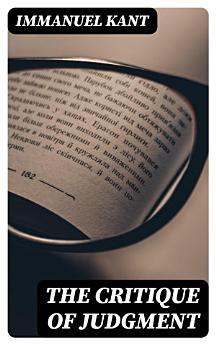The Critique of Judgment
Immanuel Kant
may, 2022 · DigiCat
E-kitob
423
Sahifalar soni
family_home
Yaroqli
info
reportReytinglar va sharhlar tasdiqlanmagan Batafsil
Bu e-kitob haqida
In "The Critique of Judgment," Immanuel Kant meticulously explores the intricate relationship between aesthetics and teleology, positioning judgment as a critical faculty that bridges the domains of the sublime and the beautiful. This seminal work is divided into two main sections, the Critique of Aesthetic Judgment and the Critique of Teleological Judgment, offering profound insights into the nature of human perception and the principles governing our appreciation of art and nature. Kant employs a distinctive philosophical style, combining rigorous analysis with eloquent prose, reflecting the Enlightenment's quest for objectivity and universality amidst subjective experiences. Immanuel Kant, a central figure in modern Western philosophy, was significantly influenced by the Enlightenment ideals of reason and freedom. Writing "The Critique of Judgment" in 1790, he sought to bridge the gap between empiricist and rationalist thought, examining how aesthetic values and notions of purpose resonate within human consciousness. Kant's rich intellectual heritage, including his engagement with the works of Rousseau and Hume, profoundly shaped his inquiries into the aesthetic and teleological dimensions of human experience. This book is essential for those interested in philosophy, art, and science, offering a fundamental understanding of how we evaluate and appreciate beauty and purpose. Readers will find Kant's reflections not only intellectually stimulating but also highly relevant to contemporary discussions surrounding aesthetics and the nature of judgment.
Muallif haqida
Immanuel Kant, born April 22, 1724, in Königsberg, then part of Prussia, is one of the most influential philosophers in the history of Western philosophy. His comprehensive and systematic work in epistemology (the theory of knowledge), ethics, and aesthetics greatly influenced all subsequent philosophy, especially the various schools of Kantianism and idealism. Kant's endeavor to set out to the limits of metaphysics and understanding led to what is often considered his greatest work, 'The Critique of Pure Reason' (1781/1787), establishing his reputation as a foremost thinker. His 'The Critique of Practical Reason' (1788) is central in his moral philosophy, whilst 'The Critique of Judgment' (1790), the third of his seminal triad, delves into aesthetics and teleology. It bridges the gap between the natural world and the moral world, providing a comprehensive framework for his aesthetic theory, notably his analyses of beauty and the sublime. Kant's critical style of philosophy was aimed at solving what he perceived as shortcomings of past doctrines, setting the stage for many philosophical debates that would follow. He passed away on February 12, 1804, in Königsberg, where he had lived all his life, but his writings continue to resonate and shape philosophical discussion today.
Bu e-kitobni baholang
Fikringizni bildiring.
Qayerda o‘qiladi
Smartfonlar va planshetlar
Android va iPad/iPhone uchun mo‘ljallangan Google Play Kitoblar ilovasini o‘rnating. U hisobingiz bilan avtomatik tazrda sinxronlanadi va hatto oflayn rejimda ham kitob o‘qish imkonini beradi.
Noutbuklar va kompyuterlar
Google Play orqali sotib olingan audiokitoblarni brauzer yordamida tinglash mumkin.
Kitob o‘qish uchun mo‘ljallangan qurilmalar
Kitoblarni Kobo e-riderlar kabi e-siyoh qurilmalarida oʻqish uchun faylni yuklab olish va qurilmaga koʻchirish kerak. Fayllarni e-riderlarga koʻchirish haqida batafsil axborotni Yordam markazidan olishingiz mumkin.








